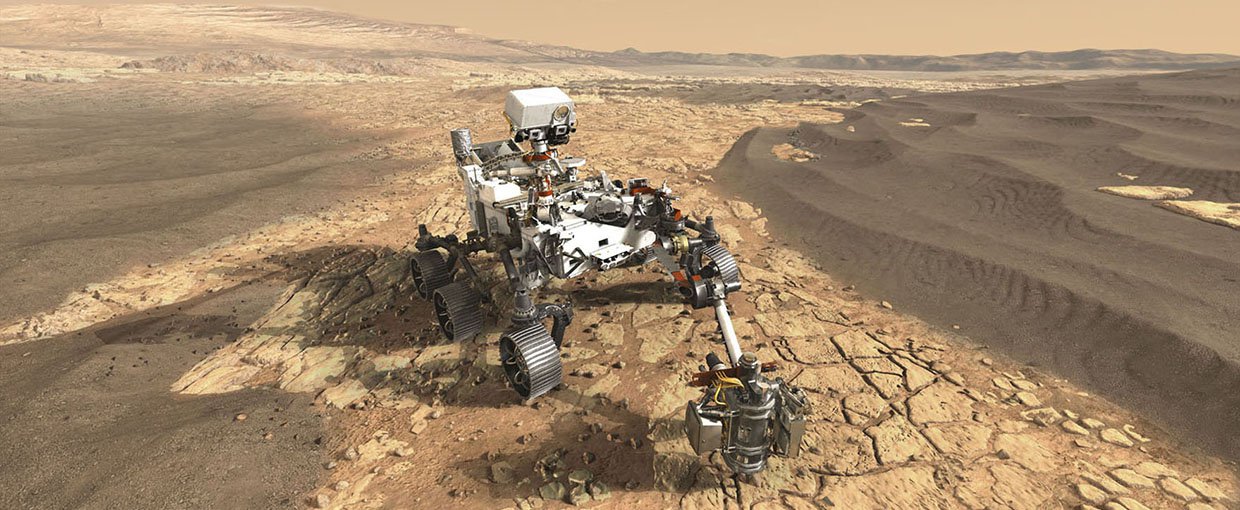
The search for life, or signs of past life beyond Earth is now a central issue in space science, is central to the mission of NASA, and is actually a potentially breakthrough discovery in the making for humanity. The scientific stakes could hardly be higher.
But identifying evidence of ancient microbial life – and refuting all reasonable non-biological explanations for that evidence — is stunningly difficult.
As recent wrangling over Earth’s oldest rocks in Greenland has shown, determining the provenance of a deep-time biosignature even here on Earth is extraordinarily difficult. In 2016, scientists reported discovery of 3,700 million yr-old stromatolites in the Isua geological area of Greenland.

Extremely high definition images of the components of rocks and mud as taken by PIXL, the Planetary Instrument for X-ray Lithochemistry. On the Mars 2020 rover, PIXL will have significantly greater capabilities than previous similar instruments sent to Mars. Rather than reporting bulk compositions averaged over several square centimeters, it will identify precisely where in the rock each element resides. With spatial resolution of about 300 micrometers, PIXL will conduct the first ever petrology investigations on Mars, correlating elemental compositions with visible rock textures.Image credit: NASA.
Just three years later, a field workshop held at the Isua discovery site brought experts from around the world to examine the intriguing structures and see whether the evidence cleared the very high bar needed to accept a biological interpretation. While the scientists who published the initial discovery held their ground, not one of the other scientists felt convinced by the evidence before them. Watching and listening as the different scientists presented their cases was a tutorial in the innumerable factors involved in coming to any conclusion.
Now think about trying to wrestle with similar or more complex issues on Mars, of how scientists can reach of level of confidence to report that a sign (or hint) of past life has apparently been found.
As it turns out, the woman who led the Greenland expedition — Abigail Allwood of NASA’s Jet Propulsion Lab — is also one of the key players in the upcoming effort to find biosignatures on Mars. She is the principal investigator of the Planetary Instrument for X-ray Lithochemistry (PIXL) that will sit on the extendable arm of the rover, and it has capabilities to see in detail the composition of Mars samples as never before.
The instrument has, of course, been rigorously tested to understand what it can and cannot do. And one of the ways it was tested was by analyzing what was claimed to be the world’s oldest fossil, in Greenland. An important finding in the paper by Allwood et al challenging the initial stromatolite identification came from from a PIXL study of the rock.
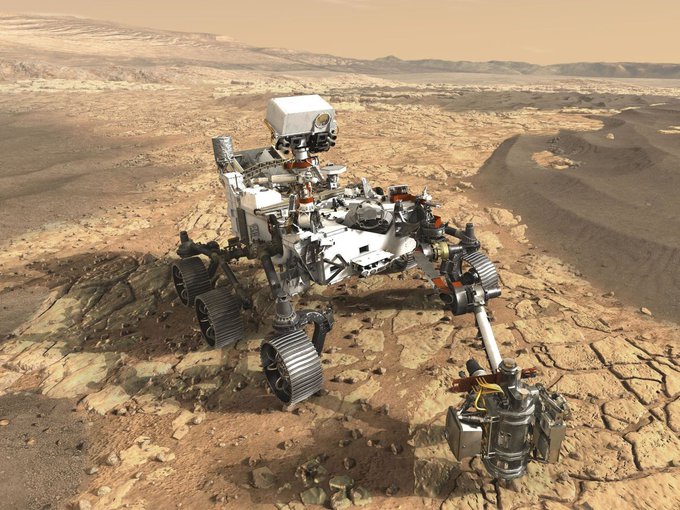
An artist conception of the 2020 rover on Mars. The PIXL instrument is at the end of the seven-foot extendable arm, along with two other instruments designed to (among other tasks) identify promising sites for PIXL.Image credit: NASA, JPL-Caltech.
“There is a real possibility that the team will find itself attempting to evaluate a potential biosignature on Mars in the next five years,” Allwood said. “When that happens, we need to already have a pretty detailed, solid understanding of the processes that formed the rocks we find that potential biosignature in. Otherwise we might get a false positive.”
Before getting into the working of PIXL, a little background:
Microbes change the texture and chemistry of their environment. An example that NASA likes to give is the plaque your dentist scrapes off your teeth. That hard stuff is minerals left behind by millions of bacteria. It’s an example of a “biofilm.”
Biofilms form when a group of microbes stick together to form a surface. You can find biofilms on surfaces everywhere in nature. PIXL can detect signs of biofilms made by microbes in the Martian environment long ago because rocks can and sometimes do preserve their texture and chemistry.
This relates directly to the stromatolite issue in Greenland, because stromatolites are mounds of sediment that once had biofilms between their layers of non-biological material. Sediments in the water would stick to the gluey biofilms, form a layer, and then result in more biofilms growing on top of the layer to get the life-supporting material it needed.
What is new about PIXL is the level of detail it provides. PIXL uses a very tiny (about 0.3mm diameter), powerful x-ray beam to rapidly measure the elemental chemistry of rocks. In about 10 seconds, it can accurately measure the elemental chemistry of an individual grain of sand. Scanning the beam across the surface of the rock, PIXL can acquire a postage stamp-sized chemical map overnight, while the rover is “sleeping”.
PIXL can detect some of the kinds of miniscule or faint changes that life brings to the chemistry of rocks or minerals. It can, for instance, detect unusual and meaningful concentrations of a particular element or compound, it can find other anomalies known to be produced by biology, it can potentially detect changes in the textures and forms of rock details down to the rock grain to tell if perhaps a biofilm was once present.
“Interpreting the geological past, unravelling the details of ancient environments – that is the bread and butter of any geological or astrobiological investigation,” Allwood said.
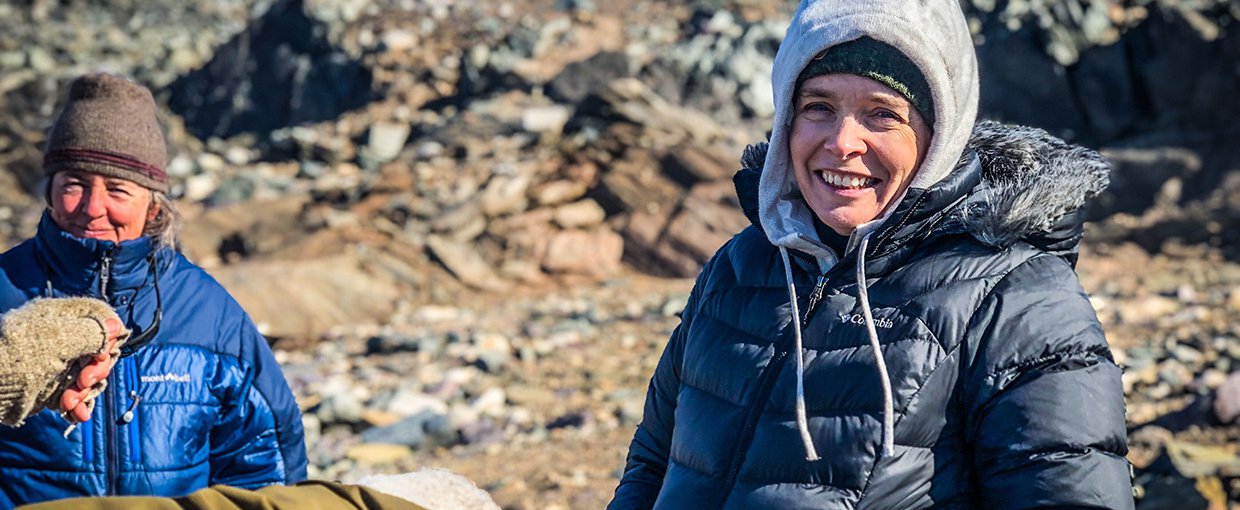
Dawn Sumner (left) and Abigail Allwood (right) at the field site in Greenland.Image credit: Mike Toillion/NASA Astrobiology.
In fact, if some hint of possible biological activity is found, having a good grip on the geological story ahead of that discovery helps with interpretation of the origin of the discovered feature.
Probably the key question — is whether it could have been produced by geological, geochemical or other non-biological processes. You may recall the high-profile report in 1996 that a meteorite from Mars found in Antarctica had a high probability of containing signs of ancient Martian life. Big news, but ultimately a finding that did not produce a scientific consensus because those several proposed signs of past life could be and were explained by other non-biological processes.
The origin story of the PIXL instrument makes that biosignature connection clear.
In the 2000s, then graduate student Allwood spent a great deal of time researching the 3,450 million yr-old Strelley Pool Formation, in the Pilbara craton of Western Australia.

Abby Allwood outside of Nuuk, Greenland. She is a geologist and astrobiologist who specializes in faint signatures of ancient life detected through analysis of chemicals and rock textures.Image credit: Mike Toillon/NASA Astrobiology.
The Pilbara was where ongoing debate about the antiquity of life on Earth was playing out. She decided to focus on the putative stromatolites of the Strelley Pool Formation, and spent the southern winter months each year traipsing along ridges where outcrops of the formation could be found, piecing together an understanding of the ancient environment once present and observing the stromatolites.
During her years of work in the Pilbara studying extremely old stromatolite fossils, she used an x-ray fluorescence microscope that allowed her to see the chemical compositions of the tiny rock components that she was seeing under a conventional transmitted light microscope.
Her work in the Pilbara, with colleague and later husband Ian Burch and others, led to major findings published in a 2006 Nature paper and a 2009 Proceedings of the National Academy of Sciences paper reporting the existence of an ancient microbial reef system, of which the stromatolites were part.
Allwood was selected to do postdoctoral work at NASA’s Jet Propulsion Lab and, when the call went out for scientific instruments to ride the 2020 Mars rover, she proposed an instrument based on the x-ray fluorescence that worked so well in the Pilbara.
Her instrument was chosen and she became the first woman ever to be the principal investigator for an instrument going to Mars, and the first Australian too.
PIXL fires a thin x-ray beam at a rock and the excited atoms it hits send back their own specific x-ray signatures depending which element the atom is– the phenomenon of flouresence.
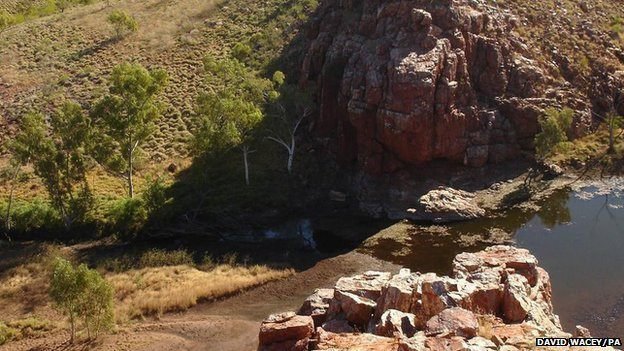
Strelley Pool in Western Australia, where Allwood and colleagues developed some of the technology and methodology that was used to construct PIXL.Image credit: David Wacey.
PIXL also has an Optical Fiducial System, consisting of a micro context camera (MCC) and Flood Light Illuminators (FLI) contributed by the Danish Technical University, two structured light illuminators (SLI), and some very smart software that allows PIXL to make decisions without humans involved. (Artificial Intelligence, by some definitions).
It also has a hexapod: six motorized legs that enable PIXL to be positioned precisely relative to the target. Combined, those capabilities allow PIXL to create finely detailed chemical and textural maps of the rock, potentially revealing the past presence of microbes.
As Allwood explained it, “PIXL will be the first instrument on Mars to do petrology—the discipline that seeks to understand the origins of rocks by studying their composition, as it relates to their texture.” Data sent back by earlier Mars rovers (including Curiosity) allowed scientists to study rock chemistry, but lacked the spatial resolution to measure the chemical compositions of tiny rock components that could be seen in the high resolution cameras.
The 2020 rover will have four science cameras in addition to PIXL. It will be a workhorse alongside the others, Allwood says, and part of a highly advanced team.
Using all this information and more, NASA will potentially be able to make far more informed judgments about how rocks formed, which rocks might contain evidence of life, and consequently which samples should be brought to Earth in the future for further tests.
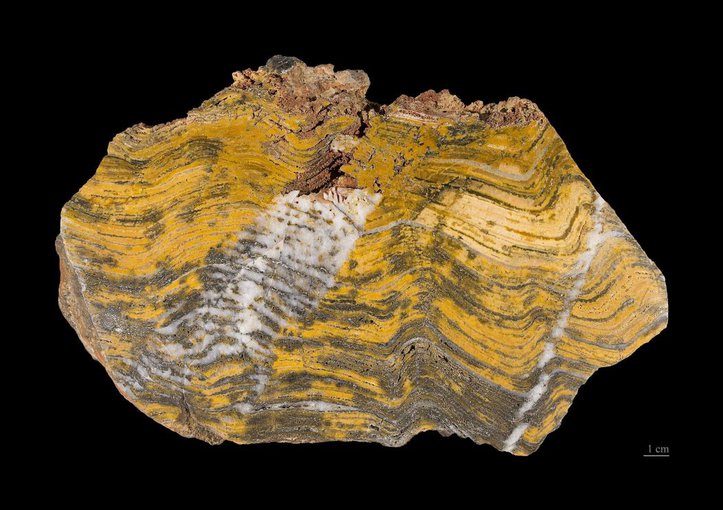
A fossil stromatolite, with clear laminations, from Strelley Pool in Western Australia.Image credit: Wikipedia.
The 2020 rover is headed to Jezero Crater, a site that has been tempting Mars experts for years. Twenty-eight miles wide, Jezero will give the mission a unique opportunity to study sedimentary rocks that formed in the presence of a standing body of water. A river delta is preserved at the western margin of the crater and there are also distinct in-flow and out-flow channels around the edge of the crater, and concentrations of intriguing minerals and rocks to be studied.
As explained by PIXL deputy principal investigator Joel Hurowitz, a geochemist at Stony Brook University, the instrument can probe rocks of all kinds and will be especially useful in studying the carbonate minerals (identified from orbiting satellite observations) that occur in and around the crater.
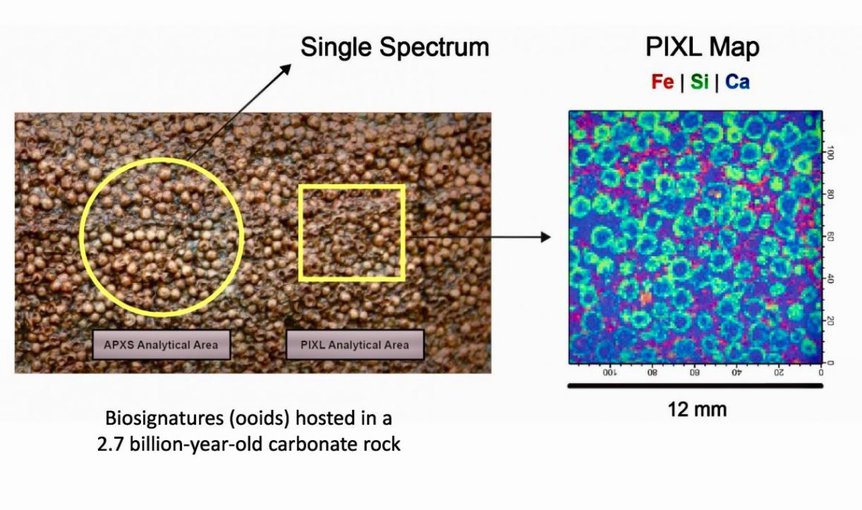
What PIXL, and its micro-x-ray fluorescence, can show, compared with the definition from an Alpha Particle X-Ray Spectrometer or APXS. The PIXL map identifies the presence of iron, silicon and calcium, and arranged in ways that suggest biology might have been involved in the composition of the rock. As Allwood put it, “to look for microbial evidence you have to look on a microbial scale.”Image credit: Nicolas Michel-Hart, University of Washington.
Carbonate rocks, such as limestone and dolomite, are often associated with biological systems, such as reefs and seashells on Earth. They may also form by direct mineral precipitation from water, such as occurs in an evaporating lake.
Hurowitz said that the heaviest concentrations of Jezero carbonates appear to be along the edges of the floor of the crater. This means that if Jezero once held a lake — as was found at Gale crater, which is being explored by the Mars 2020 near-twin, Curiosity — the carbonates would have built up in the most shallow waters, an environment conducive to the long-ago presence of life.
“These in situ-precipitated minerals are really interesting for all sorts of reasons, not least of which is the possibility they may contain evidence of microbes.”

Joel Hurowitz is a geochemist and planetary scientist at Stony Brook University. He has worked on the science collected by Mars rovers since 2004.Image credit: Stony Brook University.
Rapid mineralization is one way of preserving fossils. But even if fossils aren’t directly preserved, these “authigenic” minerals (formed in their current position) capture many different kinds of telltale clues, like trace element ratios and isotope patterns that provide detailed information on water chemistry, climate, the dating of rock formations and geological events.
‘You’d have to be extremely lucky to get a sample with an identifiable, smoking-gun kind of microfossil inside, but if you have authigenic minerals there are multiple ways that evidence of the existence of a martian biosphere might be deduced from the study of those minerals” says Allwood.
What PIXL will be able to do, Hurowitz said, is to identify the chemical components of a rock at the highest resolution ever, and will also be able to collect data on the textures of the rocks on a grain-size scale.
“What makes PIXL unique is its ability to tie the rock chemistry and texture together at the millimeter to sub-millimeter scale,” Hurowitz told me. This will allow the team to figure out whether a detected carbonate came directly from the lake water of Jezero as layers of relatively pure carbonate mineral, or were deposited as cement between grains of sand, or appeared as a replacement of some earlier mineral that was dissolved by carbon dioxide-bearing waters and donated its chemistry to the fluid to make carbonate minerals.
Can PIXL tell us whether a particular feature in the carbonates is produced by life?

Jezero Crater contains the fossil remains of a river delta and is where the Mars 2020 rover will land. The image, taken by NASA’s Mars Reconnaissance Orbiter (MRO), uses non-Martian colors to highlight specific features and mineral deposits. The MRO spectrometers found clays and carbonates altered by water.Image credit: NASA/JPL-Caltech/ASU.
Hurowitz, who was also on the Greenland stromatolite expedition, said that a clear lesson from Isua is that any interpretation of the long-ago presence of life will hinge on a lot more than the measurements made by one instrument. And even if the PIXL team was able to mount a compelling case for the potential biogenicity of sample in Jezero — whether it’s made of carbonate or not) — there will be scientist who disagree with that interpretation.
“Determining biogenicity will be a team effort that all of the instruments will contribute in some way to,” he said. “And then, even with a solid case for a biosignature or a rock with high biosignature preservation potential, we’ll still want to bring a sample of that rock home to analyze on Earth.”
The Many Worlds Blog chronicles the search for evidence of life beyond Earth written by author/journalist Marc Kaufman. The “Many Worlds” column is supported by the Lunar Planetary Institute/USRA and informed by NASA’s NExSS initiative, a research coordination network supported by the NASA Astrobiology Program. Any opinions expressed are the author’s alone.
